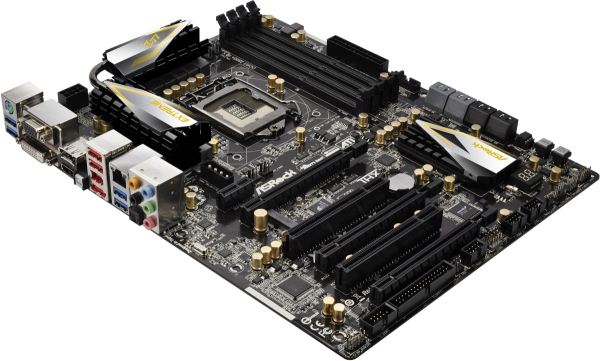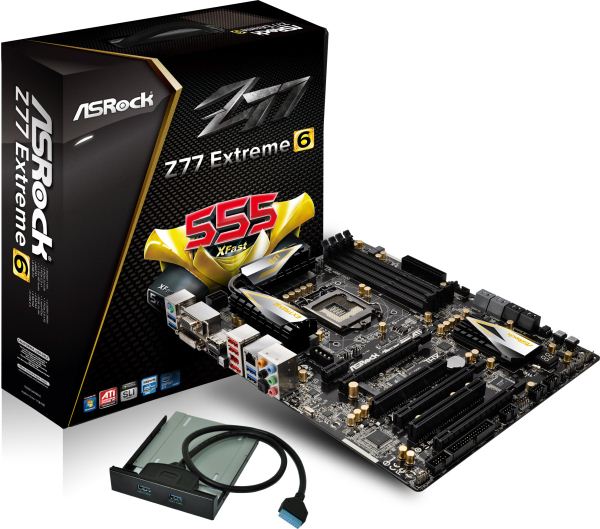ASRock Z77 Extreme6 Review: Legacy Bites Back
by Ian Cutress on July 13, 2012 2:00 PM EST- Posted in
- Motherboards
- ASRock
- Z77
The ASRock Z77 Extreme6 looks like a good motherboard on paper. If we do direct comparisons to the Z77 Extreme4, we have more substantial heatsinks, a floppy port, the full array of video outputs and a third PCIe slot at the bottom powered from the chipset.
The board itself is slightly bigger than the Extreme4, because the Extreme4 was actually smaller-than-ATX. However, the extra real estate is costing another $35, and we are not getting anything in the way of performance that excels. A quick glance over our benchmark suite and you will notice that the Z77 Extreme6 just does not light up the charts. It is usually in the middle of the road, of even worse, at the bottom.
The main thing the Z77 Extreme6 has going for it is the overclocking. All of the auto overclocking options worked first time, and plugging in my normal overclocking technique gives us some of the best results we have ever had for 4.7 GHz. Nevertheless, I did experience issues in getting my memory kit (G.Skill DDR3-2400 9-11-11) to work properly at XMP. Another plus side is that we get that awesome USB 3.0 front bracket in the box which doubles as an SSD holder.
Software wise, we do get a nice selection of network management software as well as RAM-Disk tools for temporary files. The software needs to be all bundled together as much as possible to feel more streamlined to users, as well as pulling some of the features in the BIOS (Dehumidifier, Online Management Guard) out into the software.
The BIOS is well built and laid out appropriately. There is room to move with regards how graphical BIOS can capture the imagination of the artist, and I am told we should expect something better for the later chipsets due out this year.
Simply put, some motherboards are a joy to work with. Every corner you turn they give you a little bit more. Even if the differences to other motherboards are minor, often a little spark improves your experience. ASRock ideas such as Internet Flash and OMG are good, but their implementation needs to be refined. ASRock are on the road to becoming one of the top tier manufacturers and joining the ranks of ASUS and Gigabyte, but the Z77 Extreme6 is not it. It gives you a nice overclock that removes the performance issues at stock speeds, but I cannot find much to get excited about.












35 Comments
View All Comments
albiglan - Friday, July 13, 2012 - link
I liked the parts about the difficulty in reviewing motherboards and the explanation of the humidity feature. (Overclocking could maybe have benefited from a table layout)Would be nice to see additional benchmarks for things not directly related to performance (something that covers things like ease of setup, stability, etc. that is easy to compare against other mobos...)
IanCutress - Friday, July 13, 2012 - link
I have a board on the test bed now that was a little different to set up - all the additional controllers had to be installed one by one. Every other board manufacturer usually has a one button install for drivers and software. Odd.It is hard to benchmark stability. We don't have infinite CPUs to keep all the boards running for days. I only have one CPU, and when one motherboard is tested I move it on to the next one. All I can do are my PovRay/OCCT tests to make sure it won't fall over in the first five minutes or so. I'm sure there are owners of these boards (like cknobman) who have been using these boards in a real world context that can give you a hint as to how they feel about their boards :)
Ian
xodius80 - Friday, July 13, 2012 - link
please anand, its time to move into the future of computing, we need a floppy port benchmark to see how well the chipset handles the data over competing products.thank you.
extide - Friday, July 13, 2012 - link
Or are the pictures of the ATX headers on ALL ASRock boards show a bowed motherboard? I swear I have seen that like 2-3+ times before.Draconian - Friday, July 13, 2012 - link
I'm disappointed they didn't include an IDE port. It really would've made this board stand out from the competition. I'm in the market to buy a Z77 board in the next month or so.My wish list for a Z77 board:
Thunderbolt, IDE, and eSATA on the same board
Don't care about Floppy or mSATA
arthur449 - Friday, July 13, 2012 - link
Buy a cheap IDE->SATA converter for your older drive. One of the requirements of the SATA standard was that it be backwards compatible with IDE.Or get a USB 2.0 to IDE converter (I'm not certain if USB 3.0 -> IDE converters exist for cheap). You'll be limited to ~40MB/s, but you'll have hotswap functionality without the potential headache of making sure old school IDE drives are run in IDE mode instead of the usual AHCI that most folks prefer for NCQ support.
geforce912 - Friday, July 13, 2012 - link
IDE is a parallel bus and it is not compatible with SATA which is a serial point to point connection (Hence SATA is not backwards compatible with IDE). Those IDE>SATA converters are active converters and not just simple wire-crossing. Same goes for usb which is serial point to point.ypsylon - Saturday, July 14, 2012 - link
Seriously, both additions are completely pointless. To some extent I can understand IDE, perfect for equally antiquated optical drives which are still around, but floppy.... I haven't used those in years, something around 10 for sure. If somebody need floppy then USB floppy is the logical choice. If AsRock are so concerned about legacy support then where is Fast SCSI port? I still own my first FastSCSI HDD for sentimental reasons. It weights ~ as much, as car battery but it works.duffman55 - Saturday, July 14, 2012 - link
I just upgraded my computer with the ASRock Z77 Extreme4 at the beginning of the week. It consistently threw a blue screen error a few seconds after it started to load Windows which I found out was because I didn't have the AHCI drivers installed. I had to switch to IDE mode, boot up, install the drivers, then switch back to AHCI.What's the difference between the IDE and AHCI modes when using a SATA drive? It makes no sense to me to have an IDE mode for SATA devices.
P.S. On the BIOS and software page you mistyped AHCI as ACHI.
Coup27 - Saturday, July 14, 2012 - link
What is a COM header? Is this a serial port under a different name?Personally I think this product makes no sense. Anybody buying a "legacy" motherboard would try and find one with native serial and parallel ports for starters. Serial is still very much alive in the automation sector with barcode readers, PLC, funky sensors etc..
Unfortunately Fujitsu are the only laptop manufacturer left making new laptops with native "legacy" ports.